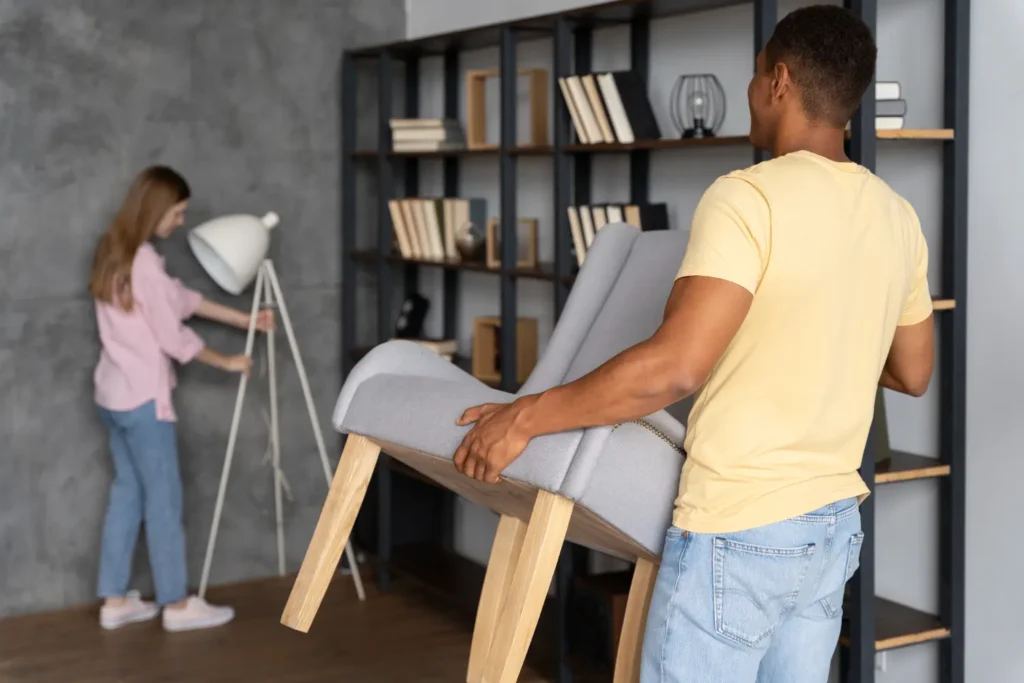Moving day is never easy, but when heavy furniture enters the picture, things can go from stressful to downright risky. Whether you’re navigating a narrow stairwell, protecting your floors, or moving a heavy piece of furniture without straining your back, meticulous planning is key.
In this guide, we’ll walk you through how to move heavy furniture safely, including stairs, carpeted areas, tight corners, and everything in between. However, please note that every moving situation is unique, and there may be instances where hiring a professional moving company is the best option. We’ll also share expert tips on when to call in professional help.
Need help moving heavy furniture? Contact E-Logic Moving for expert assistance. Let our experienced team take the weight off your shoulders and handle the heavy lifting for you.
Why Safety Matters When Moving Heavy Furniture
When it comes to moving heavy furniture, safety isn’t just a suggestion; it’s essential. Lifting oversized items like dressers, couches, and armoires without proper technique or tools can result in serious injuries, from pulled muscles and herniated discs to sprained ankles and crushed fingers. In fact, back injuries are among the most common moving-related accidents, especially during stair navigation.
But it’s not just your body at risk. Walls, floors, door frames, and even the furniture itself are vulnerable to damage if handled improperly. Scratched hardwood, dented drywall, and broken glass can turn a stressful day into an expensive one.
Some of the most common DIY mistakes include:
- Underestimating the weight or awkward shape of the furniture
- Failing to plan a safe path of exit
- Not measuring stairwells or doorways ahead of time
- Skipping protective gear or moving tools
- Attempting to “muscle through” a move solo
With some simple preparation—and a healthy dose of patience—you can stay safe, protect your belongings, and avoid unnecessary frustration. Take your time, think through each step, and don’t be afraid to pause and reassess. This sense of control and readiness will empower you to move more confidently and with fewer risks.
If at any point you feel uncertain, it’s better to seek help moving furniture than to risk injury. E-Logic Moving offers residential moving services that provide you with the relief and peace of mind you need during your move.
What You’ll Need Before You Start
Before you lift a thing, make sure you’ve got the right tools and gear. These items will make your move smoother, safer, and more efficient:
- Furniture sliders (great for carpeted or hardwood floors)
- Moving blankets
- Lifting straps or shoulder dollies
- A sturdy hand truck or dolly
- Work gloves with grip
- Stretch wrap and packing tape
Optional but helpful: stair rollers, stair-climbing dollies, or loading ramps for multi-level homes or long distances.
Pro tip: Always measure stairwells, doorways, and hallways before moving large furniture through tight spaces. This simple step can prevent potential damage and ensure a successful move.
Explore our Professional Packing Services
How to Move Heavy Furniture Upstairs or Downstairs
A. Moving Furniture Downstairs
When moving furniture downstairs, the goal is control, not speed.
- Plan your path and clear any clutter or tripping hazards.
- Use a dolly when possible, and always secure the item with straps.
- Lift from your legs, keeping your back straight and core engaged.
- Use lifting straps to help distribute the weight.
- Work with a partner and communicate each step, as downstairs moves require coordination.
B. Moving Furniture Upstairs
Going upstairs is trickier. Here’s how to stay safe:
- Tilt the piece at an angle so one end is elevated above the other.
- One person stays above, supporting and guiding the lift, while the second lifts from below.
- Never push from underneath. It can cause loss of balance or crushed fingers.
- Use stair-climbing dollies for bulky or heavy furniture that’s difficult to grip or maneuver.
Not sure if it’s safe to do on your own? Let our trained movers handle the hard part.
Tips for Moving Furniture on Carpet, Tile, or Wood
Different floors require different strategies:
- On carpet, use sliders to reduce friction and strain.
- On hardwood or tile, use felt pads to avoid scratching.
- Avoid dragging furniture altogether when possible; lift instead.
- Protect door frames and thresholds with towels or corner guards.
- Secure cords, rugs, or mats to prevent tripping.
Tips for Narrow Hallways, Corners, and Small Doorways
Tight spaces? No problem with the right approach:
- Disassemble furniture when possible: remove legs, cushions, or shelves.
- Use the “hooking method”: angle the item diagonally to guide it through the doorway.
- Wrap bulky pieces in moving blankets to avoid scraping paint or drywall.
- Place cardboard over the corners and trim for added protection.
Use our Complete Residential Move Checklist

When to Hire the Pros
Sometimes the smartest move is not moving it yourself. Here’s when to call in professional movers:
- Your furniture is expensive, antique, or irreplaceable
- You live in a multi-story home or high-rise building.
- You don’t have the help or experience moving large objects.
- You’re planning a long-distance move or have a tight timeline.
E-Logic’s experienced team provides full-service support, including disassembly, protection, and expert handling of even the heaviest furniture. With us, you can rest easy knowing your belongings are in safe hands.
Request a free quote and let us take care of the heavy lifting.
Final Safety Reminders
Before you start lifting that sectional or hauling a dresser up a flight of stairs, remember this:
Looking for safe, reliable support for your next move? Explore all of E-Logic’s moving services here.
Even if you’re a seasoned DIYer, moving heavy furniture is physically demanding and full of unexpected challenges. Planning ahead and using the right tools can make a big difference not just for your furniture, but for your health and your home.
Here’s what to keep in mind:
- Don’t rush. Take the time to plan your route and prepare the space.
- Lift with your legs, not your back. It’s the golden rule for a reason.
- Use the right equipment and always wear supportive shoes and gloves.
- Protect your home. Use blankets, corner guards, and sliders to prevent damage.
- Ask for help when needed. Whether it’s a friend or a professional, don’t go it alone if you’re unsure.
Ultimately, knowing your limits is a strength, not a setback. When the task feels too risky or overwhelming, E-Logic’s team of trained movers is just a call away.
Request a free quote today and let us do the heavy lifting for your peace of mind.
Frequently Asked Questions
What’s the safest way to move heavy furniture upstairs?
Use a stair-climbing dolly or lifting straps, and always have one person guiding from above. Don’t rush, and communicate clearly.
Can I move heavy furniture by myself?
It’s not recommended. Large, awkward items should always be moved with a partner and proper tools.
How do I protect my walls and floors when moving furniture?
Wrap furniture in blankets, use sliders or felt pads, and cover high-risk corners with cardboard or towels.
